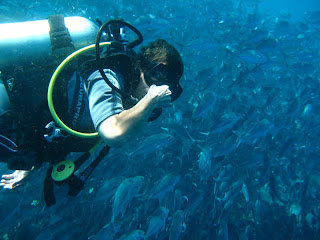The first place we went to before we left Laos in early April was Phonsavanh, Laos. The minibus ride from Luang Prabang was stunningly beautiful. It seems to follow a mountain ridge so the views (usually from switchbacks with terrifying drops) are incredible. A real eyeful of rural Laos (which is of course how most of the population lives). We saw some slash and burn either in progress or recently burnt. Villages were few and far between, but were strung out along the road, regardless of the fact that the road is on the edge of a cliff. Every village seemed to have little Lao boys running. In that heat! Beautiful to see. I was happy to see a lot of children walking to and from school. It's good that so many of the villages have schools. And every village had dogs and chickens and people on the road. This was in spite of the fact that the road is a two-lane highway - Hwy 13 - which is the main route south to Vientiane. I was happy that the minibus driver drove slowly (not over 40 km/hour in the mountains) and even stopped to let a snake cross the road. Which explains the lack of roadkill. Then for the last hour or so of the trip, we came out on the plains - a whole other world.The countryside is beautiful around Phonsavanh and the Jars are impressive. It's tragic that the locals have to deal with the UXOs - the land would be wonderful for farming if it wasn't for the bombs. And of course the land IS being used for agriculture, in spite of the bombs.
We went to the Plain of Jars. I can certainly see why the French liked to picnic at the second site of the Jars - the countryside looks like it could be England or France (except for the rice paddies, of course). We tried to take photos but they just don't capture the beautiful panoramic views. Nor do photos capture the other sensations above and beyond the sights: the bumpy, dusty, red dirt roads, the hot dry sun, the much cooler air under the huge pine trees, the smell of the pines around the jars (just like home).
Apart from the obvious attractions of the scenery and the awesomeness of the Jars themselves, the highlight of our trip was meeting a local named Manophet, who works for the UXO as an interpreter in the field during the day, then teaches English before and after work - to 240 students! He didn't intend to have so many students, but they keep arriving and insisting on staying so he can't say no. They see how good he is and that their future is brighter if they learn from him. He has a website http://www.laos-edc.com/. I certainly recommend a visit to Manophet to anyone going to Phonsavanh - his personal story is amazing, above and beyond the inspirational work he is doing with his students. Manophet teaches out of his house. He seems to have very effective techniques. We met a student of his at the second Plain of Jars site (he is a tour guide and was there giving a tour). This student spoke English very well. We were impressed. Manophet does not focus on grammar - he focuses on speaking English. He believes students learn better when doing something else, so he gets them playing soccer (and speaking only English on the field). He has SONY-ERICSSON sponsoring the soccer team (14 players) to go to some soccer competition in Sweden this July. Apparently they are good at soccer as well as English. Manophet is in the process of setting up looms at his place for weaving, so the students will be able to do that too.
- Photos -
Bizarre tractor-type vehicle, which seemed to be the norm around Phonsavanh.

Jars at the first Plain of Jars site. Easy to believe they were carved from rocks!

Bomb crater at the first Plain of Jars site, from the Vietnam war. Note that Phonsavanh is in Laos, but this area is still riddled with unexploded ordinances (UXOs) today.

MAG marker. Indicates that one side is deemed to be safe from UXOs. The other side - not. The path is lined by these markers. Deviate from the marked and worn paths at your own risk!

A tree growing out of a jar the the second Plain of Jars site.

Ron entering a bomb crater at the Plain of Jars site 2.
Ponies in a field near the second Plain of Jars site.



























